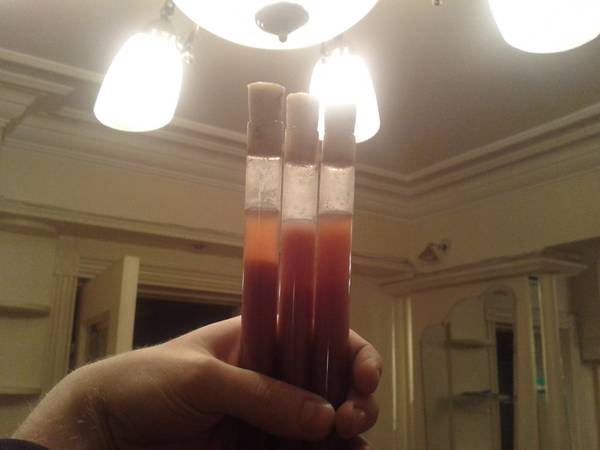CourtHouseBrewing,
That was stirring, thank you for your kind words. My wife is in-fact getting better by the day. She said, just this afternoon, that she felt as though nothing had even happened. As for the yeast, wait till you see what I have in-store now!
Considering that I am malting my own barley, I figured that my malt enzyme count was most likely wanting. In addition to this, the heavy dose of flaked wheat, flaked oats, roasted barley and peanuts will readily use up whatever alpha-amylase that is produced.
The solution seemed to be the addition of some external source of alpha-amylase. In keeping with my bright range of purples and reds, I decided to use a fungus by the name of Monascus purpureus to add this extra dose of enzymes into the mix.
After much searching, it seems I have found what I was looking for:

What you see here is known as red yeast rice. It is simply white rice that has been fermented with the mould mentioned above.
http://www.sciencedirect.com/science/article/pii/S1389172310002434
As the study states; Monascus purpureus, when placed around 35 degrees Celsius, exhibits strong cell growth. When the temperature is then dropped to 25 degrees Celsius, its alpha-amylase production experiences an 1800% increase.
My idea is to malt the pale ale part of my grain bill, as best I can. Then, the remaining ingredients will be placed onto the radiator, save the peanuts, to fermented with this fungus. It will then be moved to a cooler part of the house. After that, they will be dried once more and stored in the refrigerator to prevent further fermentation. Finally, they will be used in mashing as if they were regular malts or adjuncts, added to the boil in order to kill off all of the Monascus purpureus and activate the amylase.
To insure viability, the Monascus purpureus will be cultured and then spread unto new white rice to build up the initial culture for inoculation usage.


I was not too careful with drawing the culture into the syringe, considering the source and all. I was, however, quite careful when streaking the agar plates.
Once the colony takes foot, pictures of its growth will be uploaded. That is, of-course, if the original sample is still viable. If not, the search continues.
Edit: Please note that the red colours of the red yeast rice solution and of the previous starter vials are not related. After reading through this thread, I noticed how they look very similar and realized that some might make the mistake of thinking that they were related. This is not the case.
That was stirring, thank you for your kind words. My wife is in-fact getting better by the day. She said, just this afternoon, that she felt as though nothing had even happened. As for the yeast, wait till you see what I have in-store now!
Considering that I am malting my own barley, I figured that my malt enzyme count was most likely wanting. In addition to this, the heavy dose of flaked wheat, flaked oats, roasted barley and peanuts will readily use up whatever alpha-amylase that is produced.
The solution seemed to be the addition of some external source of alpha-amylase. In keeping with my bright range of purples and reds, I decided to use a fungus by the name of Monascus purpureus to add this extra dose of enzymes into the mix.
After much searching, it seems I have found what I was looking for:

What you see here is known as red yeast rice. It is simply white rice that has been fermented with the mould mentioned above.
http://www.sciencedirect.com/science/article/pii/S1389172310002434
As the study states; Monascus purpureus, when placed around 35 degrees Celsius, exhibits strong cell growth. When the temperature is then dropped to 25 degrees Celsius, its alpha-amylase production experiences an 1800% increase.
My idea is to malt the pale ale part of my grain bill, as best I can. Then, the remaining ingredients will be placed onto the radiator, save the peanuts, to fermented with this fungus. It will then be moved to a cooler part of the house. After that, they will be dried once more and stored in the refrigerator to prevent further fermentation. Finally, they will be used in mashing as if they were regular malts or adjuncts, added to the boil in order to kill off all of the Monascus purpureus and activate the amylase.
To insure viability, the Monascus purpureus will be cultured and then spread unto new white rice to build up the initial culture for inoculation usage.


I was not too careful with drawing the culture into the syringe, considering the source and all. I was, however, quite careful when streaking the agar plates.
Once the colony takes foot, pictures of its growth will be uploaded. That is, of-course, if the original sample is still viable. If not, the search continues.
Edit: Please note that the red colours of the red yeast rice solution and of the previous starter vials are not related. After reading through this thread, I noticed how they look very similar and realized that some might make the mistake of thinking that they were related. This is not the case.








